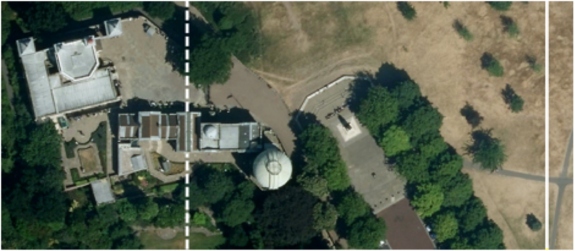The Prime Meridian of the World (dotted line) and the modern reference meridian indicating zero longitude using satellite measurements (solid line). Credit: Imagery © 2014 Google Maps, Infoterra Ltd. & Bluesky
Once called the Prime Meridian of the World, the invisible line running north to south that divides the world into Eastern and Western hemispheres passed through the Airy Transit Circle — a 19th-century telescopic instrument at the Royal Observatory at Greenwich, England.
However, this line of longitude now runs 334 feet (102 meters) east of where it did. What made it shift? A change in finding out which way is down — from using a basin of liquid mercury to relying on satellites around Earth, researchers have found.
Nowadays, any point on Earth’s surface can be described by its latitude and longitude — lines of latitude run from east to west, while lines of longitude run from north to south. Although the concept of running a grid of lines over a map to specify places on the Earth was first suggested by ancient Greek astronomer and mathematician Hipparchus in about 150 B.C., the idea did not take off until the Age of Discovery, when explorers began wandering across the globe, beginning in the early part of the 15th century.
Developing ways to pinpoint one’s latitude and longitude was one of the greatest scientific endeavors in history, a quest that ultimately took centuries and was a matter of life and death.Navigation at sea was extraordinarily challenging, resulting in countless tragedies because ships could not get a fix on where they were. One example of such a disaster happened in 1707, when four British warships and more than 1,400 lives were lost because storms forced the fleet’s navigators off course, making them believe they were safely to the west of the island of Ushant instead of closing in on dangerous rocks near the Isles of Scilly.
Finding lat. and long.
In order to define a location in terms of latitude and longitude, one first has to have starting points both for the lines running north to south, known as meridians, and those running east to west, known as parallels. In the case of latitude, the easiest place to start from and set as zero is the equator. However, the location of the prime meridian, which marks zero degrees longitude, is completely arbitrary — it could be located anywhere. Britain once ruled the waves, and so the Royal Observatory at Greenwich near London ultimately became the reference point for longitude.
Latitude is relatively easy to calculate, using an instrument such as an astrolabe to measure the altitude of the sun or a charted star over the horizon. In contrast, the key to calculating longitude is rooted in time. A line of longitude can be thought of not just as a marker of space but also of time — for instance, the eastern United States is an hour or more ahead of the western United States. If navigators can know what time it is at a fixed reference point, such as the prime meridian, the difference between the time at that reference point and the time wherever the navigators are located can help pinpoint the distance of their ships from that fixed location, and thus determine their longitude.
After inventors created timepieces accurate enough to help navigators calculate their longitude, an international conference in 1884 officially established the prime meridian through Greenwich. The prime meridian was used to establish Greenwich Mean Time, upon which all other time zones now depend.
Before clocks accurate enough to pinpoint longitude were developed, navigators gazed up at the night sky to determine time. The apparent position of the moon and stars depends on where Earth is facing, and since Earth spins on its axis at a regular pace like a clock, knowing where Earth is facing can help navigators deduce their time and longitude.
These astronomical calculations depended on navigators knowing how their instruments might be tilted with relation to the positions of the moon and stars, explained study co-author Ken Seidelmann, an astronomer at the University of Virginia in Charlottesville. The act of “determining the vertical,” or knowing which way was straight down, in turn depended on watching a basin of liquid mercury — gravity pulled the fluid downward so it was level with the horizon.
The problem with this strategy is that Earth’s gravity field varies in strength over its surface. Anything that has mass has a gravity field that pulls objects toward it, and the strength of this field depends on that body’s mass. Since Earth’s mass is not spread out evenly, this means its gravity field is stronger in some places and weaker in others.
At Greenwich, Earth’s gravity field does not pull straight downward. This means the vertical there “did not go through the center of the Earth,” Seidelmann told Live Science.
Center of Earth
In 1984, scientists began using satellites to precisely measure latitude and longitude coordinates on Earth’s surface. The verticals this strategy measures do go through the center of the Earth. The offset between these two kinds of verticals explains why the prime meridian now runs 334 feet (102 m) east of where it did, Seidelmann said.
With the aid of colleagues around the world, the researchers also found that the problem was not limited to Greenwich. “We contacted friends who knew what their coordinates had been to go out with GPS receivers to take a reading to see whether there had been a change,” Seidelmann said. “We found that each place had a different past value for their coordinates, probably based on how gravity caused a local deflection of the vertical.”
“It was fun coming up with conclusive evidence as to what really happened with the prime meridian, and why,” Seidelmann said.
He and his colleagues detailed their findings in the August issue of the Journal of Geodesy.







